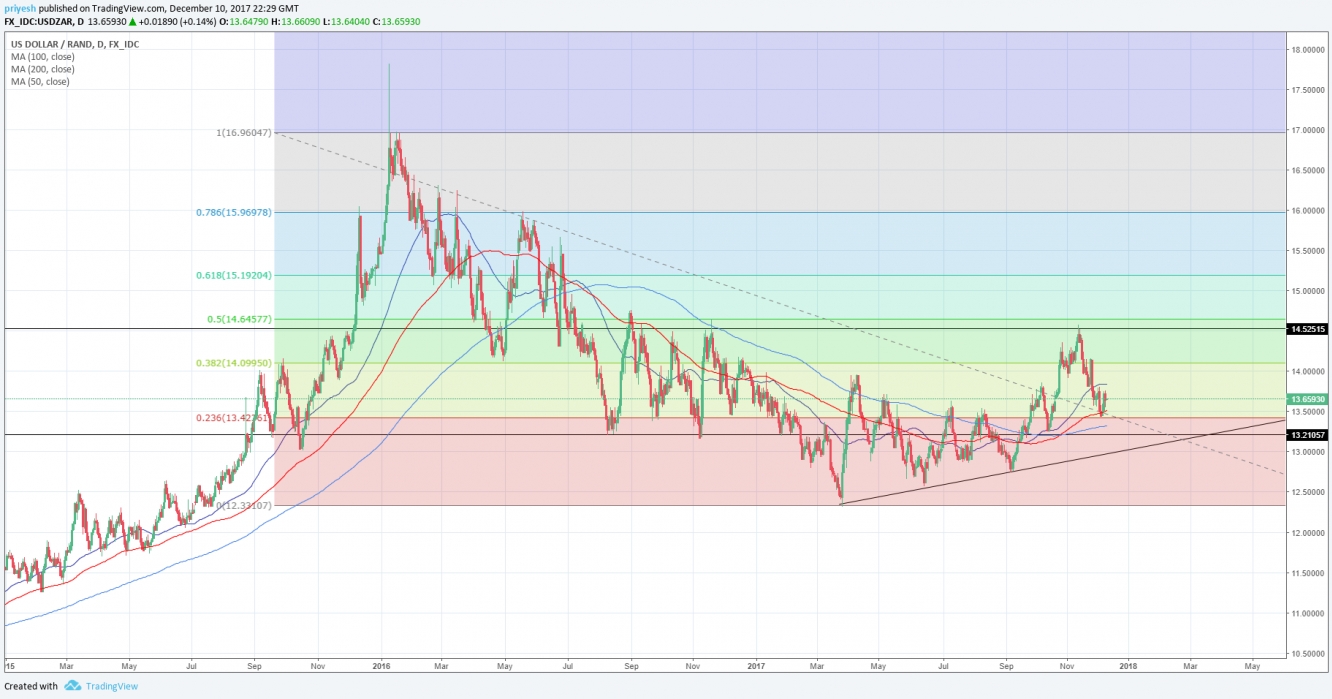Following a strong 2016 for the South African Rand and other emerging markets, 2017 has seen the US Dollar regain some ground on the rand. From a technical perspective this could simply be a retracement with the 14.50 price level and 50% fibonacci level acting as a resistance zone. However, the fundamentals suggest a different story. Many articles have been published in the final quarter of 2017 with a lot of analysts suggesting that the US stock market is heading into the final leg of its bullish run. If this is the case and we see signs of a slowdown in the US economy towards the end of 2018, investors and traders will start to lose their risk appetite and money will be moved from emerging economies and equities into fixed income assets.
South Africa have only recently bounced back from a recession earlier this year with their economy contracting in Q4 2016 and Q1 2017. GDP data released earlier this week for the third quarter saw expectations exceeded with a 2% quarter on quarter reading compared to 1.5% expectations. This was largely due to agriculture picking up again, following a drought, with about 44% growth. This eased fears of the credit ratings being downgraded by Moody’s. S&P Global and Fitch downgraded South Africa’s rating to “junk” status earlier this year whilst Moody’s has the rating at the lowest level for investment grade. All three ratings agencies have a negative outlook on the economy which could be harmed further through political uncertainty.
The current president, Jacob Zuma, has led the country since 2009 with his current term set to expire in 2019 but he could be forced to step down sooner. His presidential run has been full of controversy with corruption scandals and numerous calls to resign. He has also managed to survive multiple votes of no confidence against him. The African National Congress party are holding a conference later this month to select a new leader who will most likely succeed President Zuma. The current front runner is Deputy President Ramaphosa who is viewed as a business friendly and positive leader for the country.
The US economy, on the other hand, continues to remain strong with the major indices hitting multiple all time highs this year. The employment data this past Friday did not move the markets much with a slight beat from the NFP and a miss on average earnings. The dollar initially dropped before recovering later through the day. This could have been profit taking or traders looking forward to this week’s FOMC minutes where it is widely expected that rates will be hiked.
The markets have almost fully priced in a 25 basis points hike and traders will be more interested in whether the minutes are bearish or bullish and also the tone of Janet Yellen during her final press conference as Fed Chair. Although the FOMC are concerned about inflation, they are expecting to hike rates three more times in 2018. The first of these is expected in March 2018 with the current probability standing at 54.8%. Any sort of suggestion from the minutes that we will see more or fewer hikes next year will certainly cause a reaction. It is also expected that we will see upward revisions of economic growth projections following the recent tax reform bill that was passed through.
We also have CPI and retail sales figures being released this week and the expectations are for both to increase from the previous readings. We would also expect these figures to come out strong in January following the Christmas period. On the political front, President Trump and his government have passed through their first major legislation with the tax reform. However, it’s not all positive as the Russia investigation continues and it seems more and more likely that Russia had a hand in the elections.
Even though the US economy remains strong, they seem to be almost at the peak of the economic cycle with inflation being the only major data piece which is far off from its target. Slower growth is expected towards the end of 2018 with a possible recession in 2019. If this does happen, we would see a global domino effect and emerging markets would suffer a lot more. Overall for this currency pair, we could see the 14.5 resistance level broken next year and a bullish run towards 16.00 and 17.00. If the political situation in South Africa settles down, we would still see this pair move upwards but more gradually and over a longer time period.

